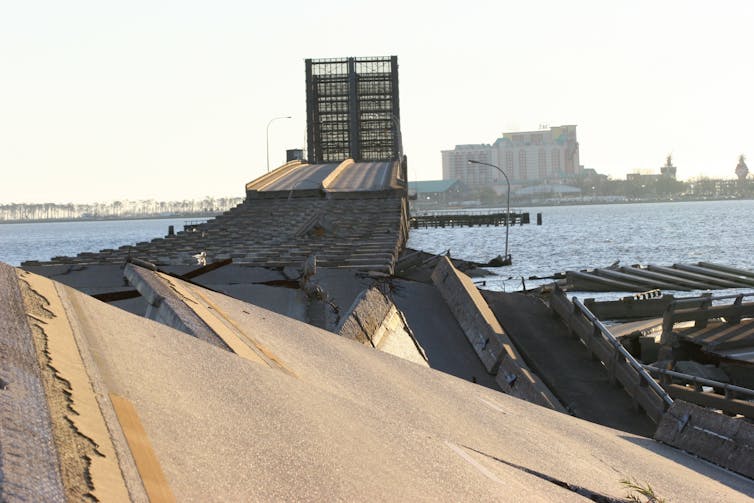Climate change is increasing the frequency of extreme weather events. For example, extreme sea-level events, where large storm surges and high tides temporarily push the sea much higher than normal, currently occur once a century. However, they are projected to strike coastal areas every decade, if not yearly, by 2040.
Events like these have significant consequences for the global financial system, such as depressing economic growth. According to research, a once-in-a-hundred year cyclone is linked to an average income loss across all countries of nearly 15% per person, surpassing the 9% average income reduction typically observed in the aftermath of a financial crisis.
The extensive damage that extreme weather inflicts on infrastructure, homes and the economy could also lead to debt that a country may struggle to repay, potentially making it harder for it to borrow money in the future. Research I carried out with colleagues found that, by 2030, climate change should result in 59 countries seeing a deterioration in their ability to repay their debts, and a subsequent increase in their cost of borrowing.
However, it appears that investors (fund managers in charge of large amounts of investments) are not paying attention to these risks. A recent article in the Financial Times revealed that oil and gas firms are facing virtually no additional borrowing costs, despite the fact that the future of the entire industry is at risk from the shift towards clean energy and global efforts to reduce carbon emissions.
Research has also found that, while investors expressed some concern about the risks associated with climate policy, the direct risks from extreme weather itself had no impact on the price of US stocks between 2000 and 2018.
Why are investors responding in this way? Not having access to the right information is only part of the equation. Investors also need to believe that climate change will actually have material consequences for financial markets.

Hurricane Katrina destroyed the Biloxi bridge in Mississippi. Robert A. Mansker/Shutterstock
Access to information
If a country seeks to borrow from financial markets for investments in public infrastructure, its credit rating will determine the cost of borrowing. The credit rating influences the interest the government will pay, akin to how an individual’s credit rating affects their mortgage repayments.
However, credit rating agencies do not consistently incorporate climate risks into their assessments. Government debt simply does not have the right climate metrics for investors to make informed decisions.
But, when investors are given the right information, they do generally make appropriate decisions. For example, research published in May 2023 explored the impact of exposure to sea-level rise on municipal bond yields in the US. (When an investor buys a municipal bond, they loan money to the local government in exchange for a number of interest payments over a defined period.)
Once presented with worst-case sea-level rise projections, investors adjusted their required rate of return on municipal bonds in coastal communities. In fact, a one-standard-deviation increase in exposure to rising sea levels resulted in a 7% to 10% increase in the cost of borrowing.
The availability of information on the financial risks associated with climate change is improving. However, much of this information is not brought together into a single place that helps financial markets analyse it.
Financial markets also require new tools to help them understand this new information. Part of the problem is that finance simply lacks the skills to understand environmental data.
Processing it differently
Access to the right information is, however, only one part of the problem. Even when investors do have access to this information, they process it differently to one another.
The same study suggests that investors in “less worried” (according to a survey of climate opinions) locations ignore sea-level projections completely. In the US state of North Carolina, for example, lawmakers have removed the requirement for long-term sea level rise projections to be included in planning applications.
The effect of sea level projections (information) on municipal bonds thus appears to be conditional on investors’ prior beliefs about climate change. The findings revealed that the projected increase in the interest rate associated with rising sea levels was only present in “more worried” locations.
Of course, investors in these locations not only needed to be worried about climate change, they also needed the right information for it to make a difference to the markets.

The US coastal state of North Carolina appears to be ignoring the risk posed by climate change. Sean Pavone/Shutterstock
What’s the solution?
Having financial data that accounts for the risks posed by climate change is a necessary requirement for incorporating these risks into asset prices. It should not be surprising that oil and gas firms maintain low borrowing costs with high credit ratings when these ratings do not consider climate risks.
Nevertheless, access to financial indicators that are adjusted for climate risks is only one aspect of the challenge. Before this new data is integrated into the decisions that investors make, the investors must be convinced that climate change actually holds significant consequences for financial markets.
In this sense, encouraging investors to recognise the impact of climate change may ultimately pose more of a sociological challenge than an economic one.



 ‘They don’t have enough’ – schools in England are running food banks for families
‘They don’t have enough’ – schools in England are running food banks for families  Impact investing in Paris suburban ‘banlieue’ neighbourhoods
Impact investing in Paris suburban ‘banlieue’ neighbourhoods  Inflation is slowly falling, while student debt is climbing: 6 graphs that explain today’s CPI
Inflation is slowly falling, while student debt is climbing: 6 graphs that explain today’s CPI  Vanguard Bans Clients From Buying Bitcoin ETFs; Users Respond With a Threat to Shut Accounts
Vanguard Bans Clients From Buying Bitcoin ETFs; Users Respond With a Threat to Shut Accounts  Orbit Chain Confirms System Breach, Issues Scam Warning
Orbit Chain Confirms System Breach, Issues Scam Warning  Etherscan Acquires Solscan Solana Block Explorer to Innovate and Expand Blockchain, Web3 Services
Etherscan Acquires Solscan Solana Block Explorer to Innovate and Expand Blockchain, Web3 Services  EU enlargement: What does the future hold?
EU enlargement: What does the future hold?  How India’s economy has fared under ten years of Narendra Modi
How India’s economy has fared under ten years of Narendra Modi  Google Play Store Blocks Binance, OKX Access in India
Google Play Store Blocks Binance, OKX Access in India  Robo-advisers are here – the pros and cons of using AI in investing
Robo-advisers are here – the pros and cons of using AI in investing  Grayscale Executives Barry Silbert, Mark Murphy Quit the Board; Mark Shifke Takeovers
Grayscale Executives Barry Silbert, Mark Murphy Quit the Board; Mark Shifke Takeovers  The yen plunges to 34-year low despite interest rate hike
The yen plunges to 34-year low despite interest rate hike 





























